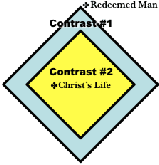 |
|
Introduction to Our Need, His Grace
Ephesians 2:1-3
(1) And you were dead in your trespasses and sins, (2) in which you formerly walked according to the course of this world, according to the prince of the power of the air, of the spirit that is now working in the sons of disobedience. (3) Among them we too all formerly lived in the lusts of our flesh, indulging the desires of the flesh and of the mind, and were by nature children of wrath, even as the rest. (Ephesians 2:1-3, NASB and throughout).
Introduction
 Contrast enables us to better appreciate things. We have contrasts like dark and light, clear and blurry, despair and hopeful, crying and joyful.
Contrast enables us to better appreciate things. We have contrasts like dark and light, clear and blurry, despair and hopeful, crying and joyful.
Each of these scenes are easily noticed and remembered. God the master teacher has done the same. The Apostle Paul has captured two of these exciting contrasts in this Book of Ephesians. The more clearly one mentally pictures these contrasts, the more one is awed, humbled, overwhelmed and grieved–all at once as the scenes flash back and forth. These two contrasts in Ephesians chapters 1-2 are meant to impress us. We do not need to overstate these truths to make them standout. We only need to unveil them. These truths are designed to rattle the very fabric of the universe and shine throughout time. One is embedded in the other. Let’s take a quick look at them starting with the embedded one.
(1) The Contrast of Christ’s Life
Paul just finished describing one contrast at the end of Ephesians 1.
Where do we find ourselves at the end of Ephesians 1? We are observing the great, mighty power and position of Jesus Christ. Let’s review a few of the many stately descriptions of Him.
Far above all rule and authority and power and dominion, and every name that is named, not only in this age, but also in the one to come. And He put all things in subjection under His feet, and gave Him as head over all things to the church, which is His body, the fulness of Him who fills all in all (Ephesians 1:21-23).
We would have to say that these terms are absolute, grand, supreme and incomparable. They describe the most glorious and wonderful Ruler of all–Jesus Christ. This, of course, is only one side of the contrast.
Paul mentions the other earlier on in Ephesians 1:7, “through His blood.” Paul does not describe with much elaboration the gruesome death of Christ along with the forsaking of His disciples. He leaves the intense descriptions for the Gospel accounts and the prophets of old. (More description on Christ's death can be found in Philippians 2:3-11 or Isaiah 52-53).
The contrast, however, is clearly set in their minds and in ours.
On the one hand we have Christ’s great suffering and on the other His glorious power and throne. In the first case, we see glimpses of weakness, vulnerability, darkness, gore, blood, grief and death. On the other, Christ’s splendor, light, beauty, majesty and awe are presented.
Each side of the contrast demands the viewer to slowly ponder its meaning. The overview, however is necessary to comprehend what really happened. Depending on one’s vantage point, one can get a different perspective. You can ask, “Why?” or “How?” We ended up with Jesus Christ full of glory, power and authority. This echoes the chorus praise that we hear in the Book of Revelation and other places. This is the embedded contrast. Let’s look at the scene that Paul spends more time on.
(2) The Contrast of Redeemed Man
This contrast helps us grasp what God has done for redeemed man. He is certainly not describing the case for all men and women here but only those redeemed in Christ. This is their inheritance. Paul only referred to two reference points in Jesus’ case. Paul excludes discussing what it was like for Christ before He came to earth. For redeemed man, however, Paul identifies three surprising reference points. This was his main purpose here to encourage the disciples to persevere in their faith.
 Paul firstly speaks about redeemed man’s situation before birth. It seems a bit awkward speaking about man before he existed but to be true to the text, the apostle mentions man in the plan of God. This is our first reference point highlighted early in Ephesians 1.
Paul firstly speaks about redeemed man’s situation before birth. It seems a bit awkward speaking about man before he existed but to be true to the text, the apostle mentions man in the plan of God. This is our first reference point highlighted early in Ephesians 1.
“Just as He chose us in Him before the foundation of the world, that we should be holy and blameless before Him. In love” (Ephesians 1:4).
“He predestined us to adoption as sons through Jesus Christ to Himself, according to the kind intention of His will,” (Ephesians 1:5).
“Also we have obtained an inheritance, having been predestined according to His purpose who works all things after the counsel of His will” (Ephesians 1:11).
Paul calls His chosen ones saints in Ephesians 1:1 and in Ephesians 1:3 says that He has blessed us with every spiritual blessing in the heavenly places in Christ. Ephesians 1 is a wonderful, unbelievable description of the man and woman saved in Christ. “In Him we have redemption through His blood, the forgiveness of our trespasses, according to the riches of His grace” (Ephesians 1:7).
The passage that we are now focusing on, Ephesians 2:1-3, is the second reference point that makes the contrast. The third reference point is discussed in the following verses. This will be saved for another time. From here on we will only focus on Paul’s second reference point of redeemed man.
The contrast is made by picturing this dark description of mankind next to the bright and special blessings recorded in chapter 1. As we step into this steep passage way of Ephesians 2:1-3, we will perhaps not find in the whole of scriptures a darker picture of mankind. This is the reference point that is found in a deep valley, or chasm, if you please, of dead spiritual bones. Although it seems like a dead end where one cannot move on from, we find it is in fact a turning point for some. If one fully understands the truths brought out in these words, then one can escape the clutches of death and gloom and go on and live in the power of Christ. We will save this discussion for another time, but we do need to remind you, that if one does not turn from this steep ledge, then they will remain far from God and all the good things that God wants to bring into their lives.
Through this study on Ephesians 2:1-3 we will discover many fascinating statements which have to do with the nature of man and a surprising clear description of why man is the way he is. Paul here answers these three questions and more.
- Why is it so easy to ignore God and do our own thing?
- Why do a father and mother argue and fight? Why nation against nation?
- Is it possible to break this power of sin over me?
These three verses each describe some special aspect of sin as it relates to man: his state, his world and his heart. We will discuss them one by one.
Next = > The Description of Man's Natural State
A) A Description of Man’s State (2:1)
B) A Descriptions of Man’s World (2:2)
C) A Description of Man’s Heart (2:3)
 Most of BFF articles such as this one is nicely formatted for printing. This article also has a Powerpoint. Check out the great number of articles on the BFF Biblical Training Library all at one low cost. Most of BFF articles such as this one is nicely formatted for printing. This article also has a Powerpoint. Check out the great number of articles on the BFF Biblical Training Library all at one low cost. |
Intro (Ephesians 2:1-3) | Man's Nature (Ephesians 2:1) | Man's World (Ephesians 2:2) | Man's Heart (Ephesians 2:3) | Questions (Ephesians 2:1-3) | mp3 download | Video podcast
Read more exciting and practical articles on the Book of Ephesians.
Introduction to the Book of EphesiansPaul's Second Missonary Journey to Ephesus - Map Ephesians 1Ephesians 1:1-3 Every Spiritual BlessingEphesians 1:1-3 Every Spiritual Blessing Ephesians 2Ephesians 2:1-3 Our Need, His GraceEphesians 2:1-3, an Introduction Ephesians 3Ephesians 3:1-10 Growing in Our Commitment Ephesians 3:20-21 God's Unlimited Power |
Ephesians 4Ephesians 4:1-3 Preserving the Spirit's UnityIntro: Problems of Disunity Ephesians 4:11-16 The Purpose of TrainingEphesians 4:11-13: A) God's Word in the Church Ephesians 4:14 B) Responsibility 1. Deceit Ephesians 4:11-14 Chart: Equipping of the Saints Ephesians 5-6Ephesians 5:22,24 Wives be Subject to your Husband |
BFF Homepage | Top | Back | BFF Topics | Ephesians 2:1-3 Study questions | Next =>
Biblical Foundations for Freedom
Paul J. Bucknell
NASB Bible used